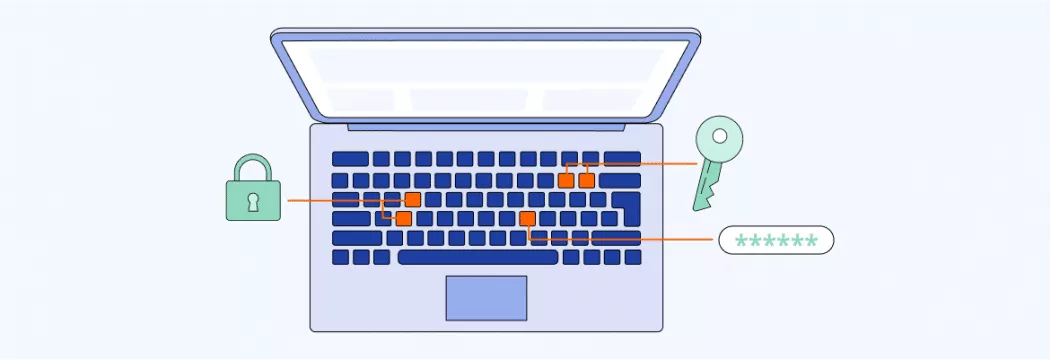How to Prevent Your Tool from Keylogging Efficiently?
Keyloggers are such malicious monitoring devices that might record everything that you type on the keyboard. Each keystroke will be watched by them. They are very dangerous. They might quietly reside in your tool, collecting the most sensitive information of yours. You might not even know that your ID data, banking details, passwords might end up in the cybercriminals’ hands….

Keyloggers are such malicious monitoring devices that might record everything that you type on the keyboard. Each keystroke will be watched by them.
They are very dangerous. They might quietly reside in your tool, collecting the most sensitive information of yours. You might not even know that your ID data, banking details, passwords might end up in the cybercriminals’ hands. However, you might prevent that.
How do the keyloggers steal your data?
The keylogger might be a piece of malicious hardware or software tool. Each type serves the same target – they log every of your keystrokes, capturing sensitive information.
Usually, software-based keyloggers come as malware, infecting computers via downloaded files or malicious links. Such keyloggers are silently running in the background so that you do not know that someone eavesdrops on the keystrokes.
The hardware keyloggers are the small physical tools that are plugged inline between the keyboard and the computer. They store the keystroke logs in the internal memory. It is impossible for the operating system to detect them. Nevertheless, they might be visible clearly if you just take a look at the PS/2 or USB port. Therefore, software-based keyloggers might be the go-to choice for the vast majority of cybercriminals.
However, not only for the cybercriminals.
Jealous spouses, protective parents that worry about what their children do online, employers that run investigations on their employees – there might be even more cases when users turned to be keyloggers to gather data. However, it might happen rarely, and mostly keyloggers are utilized by identity thieves, cybercriminals, and hackers that want to benefit from private information.
How to tell if I have the keylogger?
Here is the list of the symptoms that indicate the possible keylogger’s presence:
- Unidentified applications in your tool. The keyloggers spread similarly to malware, so if you notice the unrecognized software, there might be keyloggers on your tool.
- The device works slowly, crashes, or freezes when you utilize or type your mouse. Noticing such a lag, you might have the keylogger.
- The suspicious hardware attached. Keyloggers might be hardware-based and software-based. When you notice some suspicious attachment that is fixed to the keyboard, either a cable or something else, perhaps, there is a hardware keylogger.
- Unrecognized processes that run in your task manager. Similarly to the suspicious software, you should always check if there is any unrecognized process in your task manager.
- Suspicious exceptions in the security software. Some keyloggers might intrude on the security systems, making exceptions.
What information do you risk losing?
When the keylogger has slipped into the tool, everything that you type will be accessible and captured by the attacker. For instance, it might be your email content, personal messages, ID data, banking details, passwords, and login names. Isn’t it scary?
How to prevent keylogging?
#1. Utilize the password manager
Keyloggers are impossible to record the things you do not type. You would better use automatic form filling. The vast majority of browsers already feature such a function which is built-in, offering you to sync and save the login credentials. However, if you let the browser store the passwords, it might bring even more risk.
You might just imagine: the malicious hacker gets access to the tool, or it might be you to let someone utilize the computer. Then, what will happen when someone gets access immediately to each account you have been logged in to. Finally, relying on your browser in order to handle the account logins might be a false security sense.
Instead, the third-party application manager is the option for you to try. If the passwords are filled in automatically but not typed, keyloggers will not get them. There might be one exception if, for the first time you enter them – if your tool was infected with the keylogger, everything that you type will be susceptible to logging, including your passwords.
#2 Keep software and applications updated
If you do not want to let keylogging malware infect your tool, you should prevent it. Keyloggers might be injected into the computer via software vulnerabilities. When they are left unpatched, they will serve as the open gate for the attackers.
So you should be proactive and never skip software updates. The developers might regularly issue the security patches in order to treat the critical software vulnerability adequately. However, we are aware that hitting that skips button might always be tempting. However, you must not do that. Keep in mind that your applications and software must be updated to protect you from many negative repercussions of information theft. It is much more simple to avoid taking risks rather than to be dealing with unpleasant information loss problems afterward.
#3 Utilize antivirus
The malicious keyloggers might lurk on the sites or just hide in the downloadable files, awaiting for the inattentive victim to be fallen into the trap them. Utilizing trustworthy antivirus programs is the best method to protect you against the notorious cyber attacks that come from the web, which includes the malicious keystroke logger.
As long as the vast majority of the antivirus programs might only be fighting off the dangers and threats, they are able to recognize, and some new malware types may slip through. However, a good antivirus must be your crucial step to prevent keylogging.
#4 Remain cautious
If the keylogger is on the computer, you should have downloaded something that you must not have or clicked on the link that you must not have clicked. This is how the malware gets on the tools of incautious users.
Therefore, you should always be vigilant to reduce the risk. Just download files and apps only from the trusted sources. Think twice before you open suspicious emails – especially, do not click links in them.
#5 Modify the passwords often
If you do it, you will minimize the harm of keylogging. If you regularly modify the passwords, in general, you will protect the account. Though setting up the new password includes hitting the keys on the keyboard that might potentially be logged, this is worth risking.
If the passwords are breached via the keylogging attack, they will not always be utilized immediately. When you modify the passwords frequently, the stolen data will not be useful to the attacker.
#6 Utilize VPN
If you combine all the measures that are listed above, you will get solid keylogger protection. In order to enjoy the all-around security online, you should consider utilizing VPN to encrypt the online information. Select the trustworthy VPN service provider offering proficiency security features, and that keeps no user activity logs, like VeePN.
With VeePN you will not only enjoy unlimited traffic and bandwidth but also there are no connection logs and activity logs. Using VeePN, your location will always be hidden, and your personal information will be safeguarded. Also, it is very easy to use secure and fast VPN connections on any tool with just one click or tap. Everything operates within just a few seconds. Moreover, you might secure up to ten tools with 1 VeePN account.
Sounds interesting?
Go ahead and download VeePN now to enjoy the security and premium level of online protection. Contact us now for more information about VeePN and download it effortlessly!
VeePN is freedom
Download VeePN Client for All Platforms
Enjoy a smooth VPN experience anywhere, anytime. No matter the device you have — phone or laptop, tablet or router — VeePN’s next-gen data protection and ultra-fast speeds will cover all of them.
Download for PC Download for Mac IOS and Android App
IOS and Android App
Want secure browsing while reading this?
See the difference for yourself - Try VeePN PRO for 3-days for $1, no risk, no pressure.
Start My $1 TrialThen VeePN PRO 1-year plan







